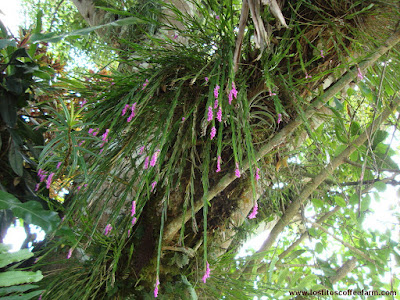Isochilus linearis is native to Mexico, Central America, the Caribbean and eastern parts of South America from Venezuela to Argentina. It is the most popular and the most widely occurring species of the genus Isochilus...
Isochilus linearis also called as The Slim Isochilus, Coilostylis obtusifolia, Cymbidium lineare, Epidendrum lineare, Isochilus brasiliensis, Isochilus leucanthus, Isochilus linearis var. leucanthus, Isochilus peruvianus, Leptothrium lineare, is a species of the genus Isochilus. This species was described by Robert Brown in 1813.
IDENTIFY ISOCHILUS LINEARIS
Isochilus linearis is native to Mexico, Central America, the Caribbean and eastern parts of South America from Venezuela to Argentina. It is the most popular and the most widely occurring species of the genus Isochilus. It can grow on the surface of the ground, attached to rocks, fallen logs or on trees. It grows usually in dense mixed forests or in mountain rainforests, and its occurrence ranges from the sea level to the height of 2000 m. Most often, however, they are found at heights of 1000-2000 m.
It is a medium sized epiphyte, lithophyte or terrestrial, which reaching 30-76 cm in height, with clustered, slender, erect becoming arching, up to 76 cm in length and have 1 mm in diameter stems enveloped below by tubular, verrucose sheaths and above carrying several, distichous, narrowly linear, obtuse, basally clasping, up to 6.5 cm long and 0.25 cm wide leaves.
The Slim Isochilus giving rise to a terminal to 6 cm long raceme with palaceous bracts, and several to many tubular, color variable flowers that can occur at any time of the year arising from the apex of the stem and held very close to the leaf. The tubular flowers are 0.8-0.9 cm long. They are variable in color, can be from almost white to dark pink-magenta, but the red-carmine color is the most popular. The lip is usually slightly darker than the other parts of the flower.
ISOCHILUS LINEARIS CARE AND CULTURE
Cultural information should only be used as a guide, and should be to be adapted to suit you. Your physical location; where you grow your plants, how much time you have to devote to their care, and many other factors, will need to be taken into account. Only then can you decide on the cultural methods that best suit you and your plants.
Light:
Isochilus linearis needs a light level of 20000-30000 lux. This species needs relatively light, filtered or scattered light and protection from direct sunlight. Strong air movement should be ensured all the time.
Temperature:
It is a plant with moderate thermal requirements, but requiring cool nights in winter In summer, the average day temperature is 21-22 ° C, and the night 12-14 ° C, with a daily amplitude of 8-9 ° C. In spring, the average day temperature is 23-24 ° C, night 10-13 ° C, which gives a daily difference of 10-13 ° C. In winter, the average day temperatures are 19-21 ° C, and the night 9-10 ° C, with a daily amplitude of 9-11 ° C. If we have a cooling air humidifier, the orchid will grow well close to the cold, humid air outlet.
Humidity:
The Slim Isochilus needs the humidity of 75-80% from the summer to the beginning of winter, then at the end of winter, for a period of almost 2 months ending the winter dry season, it drops to about 65%.
Substrate, growing media and repotting:
Isochilus linearis are easy to grow and grow well in all kinds of containers - in pots and baskets - as well as mounted on washers. However, such plants require high humidity, and during hot and dry weather, they should be watered several times a day.
These plants can also be grown in hanging baskets using a very loose, fast-drying substrate. Most growers use a medium-sized fir bark or chopped tree fern fiber. Perlite is also added to improve the permeability of the substrate and to retain moisture. The addition of charcoal also improves the permeability of the substrate, and also protects against acidification. These plants do not require any special substrate, so long as it is used, it provides good drainage and does not get thirsty. However, it also states that these plants seem to bloom better if they are grown in bark medium than in Osmund fern root stock or tree fern fiber.
The plants should be repotted immediately after noticing signs of substrate decomposition, or every few years when the plant grows out of the pot. If repotting is done at the time when new roots begin to appear, the plant will be accepted and rooted in the shortest possible time.
Watering:
In the period from late spring to autumn rainfall is abundant. Then their number drops sharply and with the winter comes the dry season lasting until the beginning of the next spring. The plants should be watered abundantly during periods of intensive growth, but excellent drainage must be provided, the air must have good access to the roots, and the ground around the roots must never be spread or soaked. When new growths reach maturity in late autumn, the amount of water should be reduced.
Fertilizer:
The plants should be fertilized every week 1/4-1/2 of the recommended dose of fertilizer for orchids. A fertilizer with a high nitrogen content is beneficial from spring to mid-summer, and a phosphorus-rich fertilizer can be used in late summer and autumn.
Rest period:
In winter, Isochilus linearis need much less water, especially at low temperatures or low light levels, they should dry a little between watering, but the substrate should never be completely dry. In most cases, a sufficiently frequent morning misting and watering every 2 weeks is enough for plants. However, the amount of water supplied should be increased if the leaves are wrinkling or show signs of weakness. Fertilization should be reduced or eliminated until new growths appear and a more abundant spring watering begins.















COMMENTS